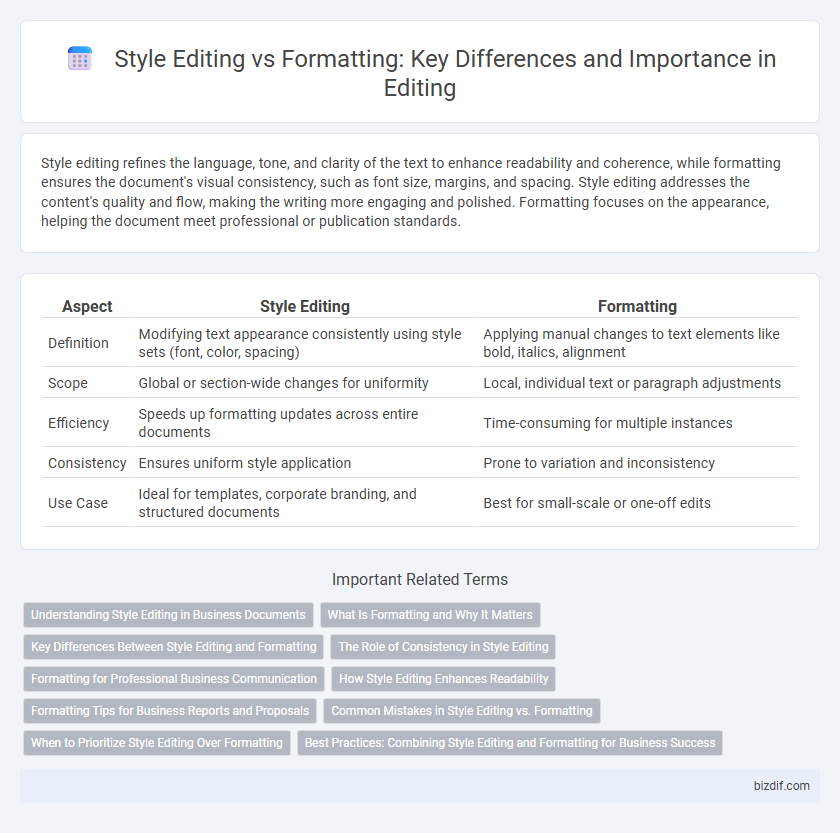Style editing refines the language, tone, and clarity of the text to enhance readability and coherence, while formatting ensures the document's visual consistency, such as font size, margins, and spacing. Style editing addresses the content's quality and flow, making the writing more engaging and polished. Formatting focuses on the appearance, helping the document meet professional or publication standards.
Table of Comparison
| Aspect | Style Editing | Formatting |
|---|---|---|
| Definition | Modifying text appearance consistently using style sets (font, color, spacing) | Applying manual changes to text elements like bold, italics, alignment |
| Scope | Global or section-wide changes for uniformity | Local, individual text or paragraph adjustments |
| Efficiency | Speeds up formatting updates across entire documents | Time-consuming for multiple instances |
| Consistency | Ensures uniform style application | Prone to variation and inconsistency |
| Use Case | Ideal for templates, corporate branding, and structured documents | Best for small-scale or one-off edits |
Understanding Style Editing in Business Documents
Style editing in business documents involves refining language clarity, tone consistency, and readability to enhance professional communication effectiveness. It focuses on aligning content with the target audience's expectations, ensuring the message is persuasive and engaging while maintaining corporate voice standards. Unlike formatting, which deals with visual layout and structure, style editing optimizes word choice, sentence flow, and overall document coherence.
What Is Formatting and Why It Matters
Formatting involves organizing text visually through font choices, spacing, margins, and alignment to enhance readability and presentation. Proper formatting ensures consistency across a document, making content accessible and professional for readers and publishing standards. It matters because clear formatting supports comprehension, prevents misinterpretation, and meets specific style or submission guidelines essential in academic, business, and creative writing.
Key Differences Between Style Editing and Formatting
Style editing focuses on improving the clarity, tone, and flow of the content by addressing grammar, syntax, and word choice to enhance readability and coherence. Formatting involves organizing the document's visual appearance including font size, margins, headings, and alignment to meet specific style guides or publication standards. Key differences lie in style editing targeting language and content refinement, while formatting ensures the document's presentation adheres to structural and design requirements.
The Role of Consistency in Style Editing
Consistency is crucial in style editing as it ensures uniformity in tone, voice, and language usage throughout a document, enhancing readability and professionalism. Style editing addresses elements such as grammar, punctuation, and word choice to maintain a coherent narrative flow, while formatting focuses on the visual presentation of the text. By prioritizing consistency, style editing helps create a polished and credible final product that effectively communicates the intended message.
Formatting for Professional Business Communication
Formatting for professional business communication ensures consistency in font types, sizes, margins, and spacing, enhancing document readability and visual appeal. Proper formatting aligns with company branding guidelines and industry standards, supporting clear message delivery and a polished appearance. Unlike style editing, which focuses on tone and clarity, formatting optimizes the structural presentation to facilitate a professional and efficient reader experience.
How Style Editing Enhances Readability
Style editing improves readability by refining sentence structure, eliminating redundancy, and ensuring consistent tone, which helps readers engage with the content more effortlessly. Unlike formatting, which focuses on visual presentation such as font size and margins, style editing targets clarity and flow of ideas. This process enhances the overall effectiveness of communication by making the text more coherent and accessible.
Formatting Tips for Business Reports and Proposals
Effective formatting in business reports and proposals enhances clarity and professionalism by using consistent fonts, headings, and spacing. Incorporate bullet points and numbered lists to organize information logically and improve readability. Maintain uniform margins and align text properly to ensure the document looks polished and easy to navigate.
Common Mistakes in Style Editing vs. Formatting
Common mistakes in style editing include inconsistent tone, improper word choice, and failure to maintain voice consistency, which can confuse readers and dilute the author's intent. Formatting errors often involve incorrect font usage, spacing issues, and improper alignment, leading to unprofessional document presentation. Confusing these processes can result in polished content that lacks visual clarity or well-designed documents that lack coherent language flow.
When to Prioritize Style Editing Over Formatting
Style editing should be prioritized over formatting when enhancing the clarity, tone, and consistency of the content to ensure the message resonates with the target audience. It addresses sentence structure, word choice, and readability, which directly impact the effectiveness of communication. Formatting becomes secondary until the style aligns with the intended purpose and audience expectations.
Best Practices: Combining Style Editing and Formatting for Business Success
Integrating style editing and formatting enhances clarity and professionalism in business documents by ensuring consistent tone, grammar, and visual presentation. Style editing refines language and voice to align with brand identity, while formatting organizes content for readability and accessibility. Adopting best practices in both elevates communication effectiveness, fostering stronger client engagement and organizational credibility.
Style Editing vs Formatting Infographic

 bizdif.com
bizdif.com